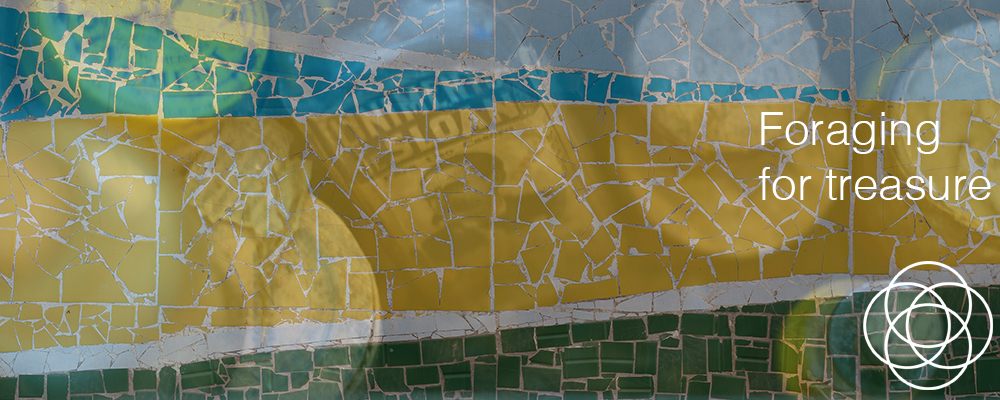I was admiring photos of broken pieces of antique pottery, hand blown glass, a clay pipe, and an inkwell, all mudlarking treasures foraged from English river mud by Carys, a friend on Instagram, and it took me back to childhood expeditions to the gardening allotments near my grandmother’s house in Portsmouth, England.
Portsmouth was heavily bombed during World War Two, with some 6,ooo houses destroyed and a greater number severely damaged. Both my maternal and paternal grandparents lived within the bombed areas, and my parents described emerging from the bomb shelters on many occasions to find nearby houses reduced to rubble. Over the next few years, prefab houses were built as temporary measures to house the homeless, and a huge council estate was built just outside Portsmouth to help accommodate the overflow. In the mid-1950s, when I was two years old, we moved to the council estate – one of Europe’s largest wholly social housing council estates – where we lived until I was nine. We rarely left the estate, as we didn’t have a car, but sometimes we would take the bus or train back into Portsmouth to visit our relatives.
I don’t really know the history of the garden allotments near my maternal grandmother’s house, but we believed they were situated on bombsites because it didn’t take much digging to find buried treasure of the kind Carys shared on Instagram.
We brought home so many bits and pieces, imagining what they had looked like whole, who had owned them, and what kinds of lives those people had lived.
Today, my Instagram mudlarking and foraging friends repurpose some of their finds as oracles, throwing them with bones, stones, and other treasures offered up by Mother Earth, interpreting the way they fall, reading into the stories their juxtapositions offer.
There’s a magic to bringing broken shards from older generations into the light of day, and letting them tell their tale, whether that tale is historically accurate, intuitively read, creatively imagined, or repurposed as healing balm.
In a grander leap of faith, we might feel we help to heal trauma from previous generations and shift our karma, individual and global, when we set out to explore buried elements of the past and use these to find ways to move forward with new purpose. When I put this notion to Carys, she said it was very apt for one of the pieces of crockery she had shared in her post, a late 1880s children’s plate from the series ‘Children at work’ made by Edge, Malkin & co.
And even if these shards we dig up and treasure were simply items thrown out as rubbish, no longer needed, perhaps they still have stories to tell, wisdom to share about letting go, or evolving.
Naturally you’re waiting for the dream analogy.
While we sleep, our dreaming mind and dreaming brain process our conscious and unconscious experiences of the last 1-2 days, comparing them to all our past experiences and building possible models for how to approach our future. This processing includes retaining some memories and information, discarding others (perhaps as broken pieces), healing, transforming, and building new perspectives.
Over the years our dreams might reference shards, shattered memories, fragments of discarded truths and wisdoms, and those dreams might spin some healing magic by drawing on what was broken or lost and putting it together in new and healing ways.
More often, though, it is we who must do that work, foraging for treasure amongst the bits and pieces from the past that show up in our dreams and applying our dream interpretation tools and techniques to put it all together to find new insight, learning, and, where needed, healing.
Take the metaphor of mudlarking, dig deep into the layers of your unconscious, and explore what your river of dreams washes up on the morning shore.
How might you piece – or peace – together broken elements of the past? Might you restore what has been broken to its original wholeness, or create a fresh or healed perspective in the same way that an artist creates a mosaic from broken shards, or a tapestry from wispy threads?
PS: A synchronicity
On Sunday, three days after posting this, I was coming to the last few pages of a book I was enjoying reading, and came upon this. (The book was not about mudlarking. This piece was totally unexpected.)
“We pause at the foot of Marygate and watch a train crossing Scarborough Bridge. The water level in the Ouse is very low for this time of year, exposing the different strata of earth and mud which line it. Everyone has left something here – the unnamed tribes, the Celts, the Romans, the Vikings, the Saxons, the Normans and all those who came after, they have all left their lost property – the buttons and fans, the rings and torques, the bullae and fibulae. The riverbank winks momentarily with a thousand, zillion, million pins. A trick of the light. The past is a cupboard full of light and all you have to do is find the key that opens the door.”
– Behind the Scenes at the Museum, Kate Atkinson
You might also enjoy


2 comments on “Foraging for treasure”